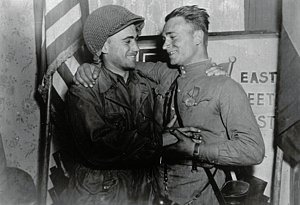1945: US and Soviet Forces Meet at Torgau
On April 25, 1945, a significant event took place in Torgau, Germany, along the banks of the Elbe River. It was a symbolic meeting between the forces of the United States and the Soviet Union during the final days of World War II in Europe. This historic encounter marked a pivotal moment in history, as it represented the nearing defeat of Nazi Germany and the coming together of two major powers.
The meeting at Torgau was a powerful symbol of cooperation between the United States and the Soviet Union. American troops, advancing from the west, and their Soviet counterparts, pushing forward from the east, joined hands on that fateful day. This gesture not only demonstrated their shared commitment to defeating a common enemy but also showcased a brief moment of camaraderie amidst the broader tensions that would later escalate into the Cold War.
The Significance of the Event
The meeting at Torgau had profound historical significance. It served as a visible testament to the military successes of the Allied forces and the imminent collapse of Nazi Germany. The joint presence of American and Soviet troops sent a powerful message to the world, solidifying the idea that victory was within reach and that the end of the war was near.
Furthermore, the meeting at Torgau highlighted the cooperation between the United States and the Soviet Union, two nations that had been allies throughout the war. It showcased their ability to work together towards a common goal, despite their ideological differences and the tensions that would later define the Cold War era.
The Legacy of Elbe Day
Elbe Day, as the meeting at Torgau came to be known, holds a special place in history. It symbolizes a brief moment of unity and cooperation between the United States and the Soviet Union, reminding us that even in the midst of conflict, common ground can be found.
The legacy of Elbe Day extends beyond the end of World War II. It serves as a reminder of the sacrifices made by both American and Soviet soldiers and the shared determination to overcome a common enemy. The meeting at Torgau stands as a testament to the power of collaboration and the potential for reconciliation, even in the face of great adversity.
References:
3. National WWII Museum – Elbe Day 1945
In conclusion, the meeting of US and Soviet forces at Torgau on April 25, 1945, was a significant event that marked the nearing defeat of Nazi Germany and the coming together of two major powers. This historic encounter, known as Elbe Day, symbolized the cooperation between the United States and the Soviet Union in their shared goal of defeating a common enemy. The legacy of Elbe Day serves as a reminder of the power of unity and collaboration, even in the midst of conflict, and stands as a testament to the sacrifices made by soldiers on both sides.

